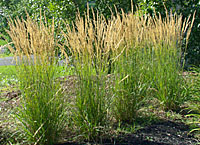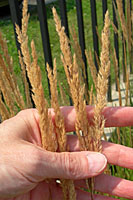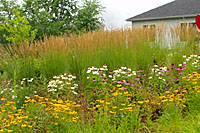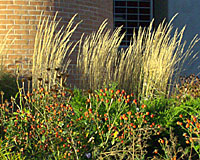Terry L. Ettinger Horticulture Consulting Services
Meeting The Needs Of Today With A Vision For The Future
Recommended Ornamental Grasses -
Feather Reed Grass
 There are more than 250 distinct forms (species) of reed grass scattered around the world, several of which are native to New York
state. However, this recommended grass, at right, Calamagrostis
x
acutiflora, is reportedly a naturally occurring hybrid between
two Eurasian species. It was first sold by a German nursery in the
late 1930's and was introduced to the U.S. in the early 1960's.
There are more than 250 distinct forms (species) of reed grass scattered around the world, several of which are native to New York
state. However, this recommended grass, at right, Calamagrostis
x
acutiflora, is reportedly a naturally occurring hybrid between
two Eurasian species. It was first sold by a German nursery in the
late 1930's and was introduced to the U.S. in the early 1960's.
 The most ornamental feature of this grass are its
tan-colored flower stems, left, that rise two to three feet above its upright clump of leaves in early June.
This gives the plant a total height of four to five feet under most
conditions. Because these stems are quite slender, the slightest
breeze sets them in motion, which lends a pleasing sense of movement
to the garden. Also, the stems do not fall apart (i.e., "shatter"),
which means they can be very effective vertical accents in both
fresh and dried flower arrangements.
The most ornamental feature of this grass are its
tan-colored flower stems, left, that rise two to three feet above its upright clump of leaves in early June.
This gives the plant a total height of four to five feet under most
conditions. Because these stems are quite slender, the slightest
breeze sets them in motion, which lends a pleasing sense of movement
to the garden. Also, the stems do not fall apart (i.e., "shatter"),
which means they can be very effective vertical accents in both
fresh and dried flower arrangements.
 The
strong, vertical form of feather reed grass lends it to a variety of
uses in landscapes and gardens - a single large plant can stand
alone as a focal point among lower growing plants, a row of plants
can be used to soften the harshness of walls or fences, or masses of
plants can be used as a backdrop for colorful, summer-blooming
perennials, above right. It can even be used as an accent in very
The
strong, vertical form of feather reed grass lends it to a variety of
uses in landscapes and gardens - a single large plant can stand
alone as a focal point among lower growing plants, a row of plants
can be used to soften the harshness of walls or fences, or masses of
plants can be used as a backdrop for colorful, summer-blooming
perennials, above right. It can even be used as an accent in very
 large
containers! And, it's equally effective in the fall when its
seedheads are backlit by the low light at sunrise and/or sunset, at
left.
large
containers! And, it's equally effective in the fall when its
seedheads are backlit by the low light at sunrise and/or sunset, at
left.
Feather reed grass thrives in full sun in soils ranging from constantly damp to very dry (once established). However, while it will persist in shaded spots in a garden, it won't produce nearly as many ornamental flower heads.
Commonly available, container-grown forms of feather reed grass include `Stricta,' 'Karl Foerster,' and the variegated-leafed `Overdam.' After a couple of years in the garden, all of these varieties can be divided at any time of year - even during the heat of mid-summer if the divisions are kept well-watered after transplanting.
Annual care involves nothing more than cutting the dead seedheads and foliage back to within two to four inches of the ground in late winter or early spring.
So, if you've been hesitant to add an ornamental grass to your landscape or garden, feather reed grass is an excellent first choice.